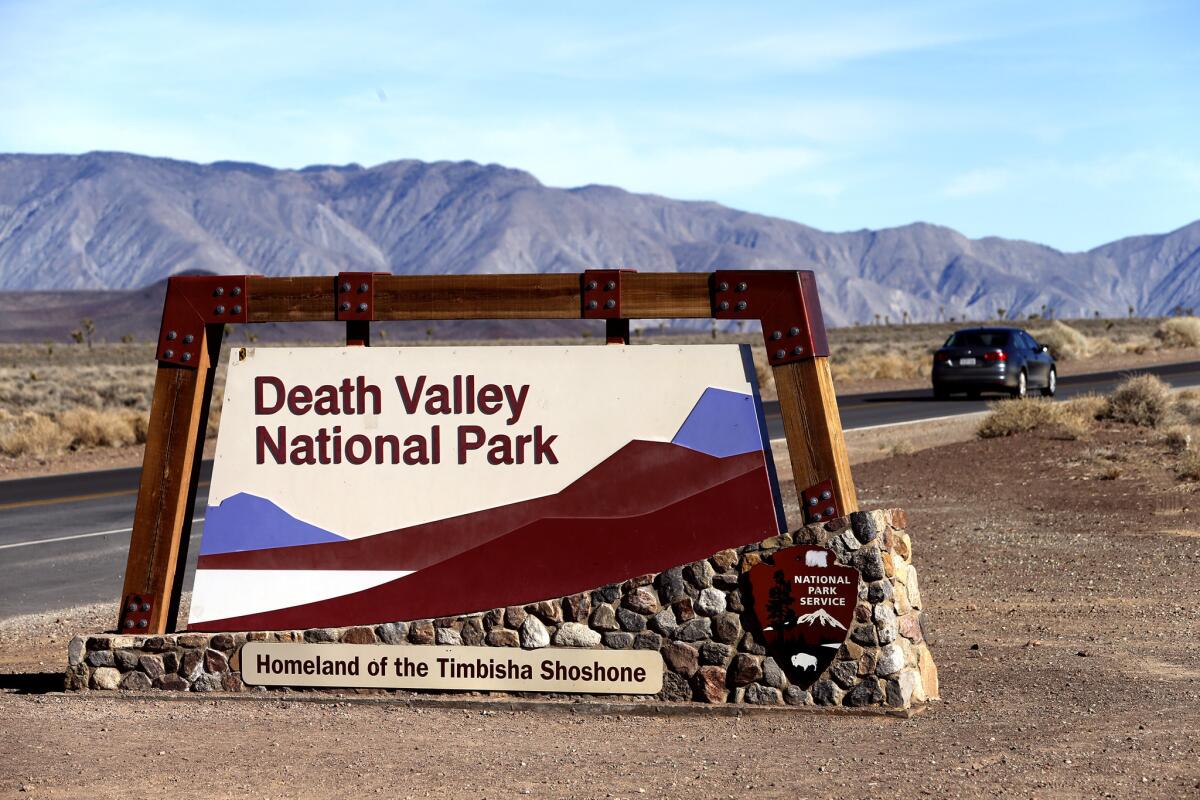Record temperatures lure ‘heat tourists’ to Death Valley National Park

- Share via
Once he saw that temperatures in Death Valley National Park had hit 130 degrees Fahrenheit, Dan Markham, 40, knew he had to go.
The southern Utah local made the drive last month and found himself in the company of dozens of other park visitors hoping to get a picture alongside a thermometer listing one of the hottest recorded temperatures on Earth.
According to Markham, visitors from Nevada, Washington and California sat in their cars, air conditioners blasting, and waited as the thermometer toggled between 129 and 130. Markham stayed for two hours.
“It would be stuck at 129 and then all of a sudden it would go up to 130 and everyone would run out of their cars to take a picture,” Markham said.
Those who missed it — and “were like, ah man, 129 again” — headed back to the shelter of their automobiles to wait for another photo opportunity.

This year will go down as the fourth-hottest summer in Death Valley history after the park recorded “some of the hottest days ever recorded on Earth,” according to the park. But intense heat hasn’t stopped visitors from coming. In fact, some are drawn by the prospect of baking in a record swelter — what park officials have dubbed “heat tourism.”
The crowd’s motivation seems anchored in the idea that “this would be a fun adventure,” Markham said. “To see what that feels like and be able to say, ‘I did this weird thing, and I got a picture.’”
Someone next to him posed with a large red bucket and a sign: “Bucket List: Be in the world’s hottest temperature.”
And by some measures, they were. On Aug. 16, the thermometer at Furnace Creek topped charts at 130 degrees Fahrenheit. This clocked in as the hottest temperature on record in the park since 1913, and likely the hottest in the world since 1931, pending official verification.
Record heat. Record acres burned. Sky-high air pollution. The extremes California has experienced in recent weeks all have one thing in common: They were made worse by climate change.
This summer averaged 102.7 degrees Fahrenheit from June to August. The top three hottest summers all occurred within the last five years, demonstrating a “continued record of a changing climate,” according to the park.
In the midst of rising temperatures, the park’s annual visitation has more than doubled in the last 10 years, with a record 1,740,945 people in 2019.
Park officials don’t discourage visitors from coming; they just request everyone proceed with caution. “These are public lands, and if we can provide safety and enjoyment, people can come and visit,” said Jennette Jurado, public information officer at the park.
To maintain that safety, the community is adapting to new norms.
Residents rise early to walk dogs and exercise between 4 and 6 a.m., striving to beat the heat.
When motorists are making some steep ascents, road signs encourage them to turn off their air conditioning. Keeping it on in these temperatures creates a risk of engines overheating. And a few have, resulting in two vehicle fires this summer and multiple cars breaking down.
Additionally, homes in the valley now have naturally occurring “extremely hot” tap water due to rising ground temperatures. To adapt, residents are turning off their hot water heaters and using them instead as “reservoirs to cool water down.” If done successfully, they can have room-temperature water come out of the hot faucet, and hot water come out of the cold.
For weeks, millions of Californians were smothered by smoke from wildfires. Many worry about long-term health impacts.
Markham, who is a YouTuber, also played 18 holes of golf that day in the heat as part of a personal goal and to create a video.
His conclusion, after noticing his exercise watch mark his highest heart rates yet and losing 5 pounds over the course of the day: “Humans just don’t seem set up to be in 125-degree temperatures for a long amount of time.”
Even so, he said that the next time temperatures got that high, he would come back and hoped to bring his whole family.
Park officials don’t recommend recreation after 10 a.m. in summertime. There is real danger in such heat. The park has seen two fatalities this summer, one in July and one in September. In both cases, heat is considered a likely contributing factor to the cause of death. The day before one hiker died on Sept. 6, the high was recorded at 123 degrees. “Those are really hard days to be a park ranger,” Jurado said.
The park has no precedent of closing because of extreme weather. Instead, officials offer recommendations on how to visit the environment safely.
To those hoping to experience it all for themselves, Jurado recommends to “be here at dawn and see the park from your car.”









